浮头式换热器毕业设计说明书论文
- 格式:doc
- 大小:2.36 MB
- 文档页数:70
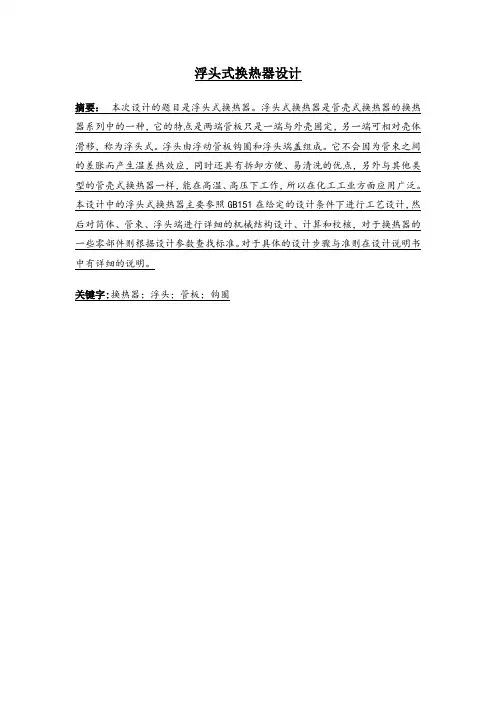
浮头式换热器设计摘要:本次设计的题目是浮头式换热器。
浮头式换热器是管壳式换热器的换热器系列中的一种,它的特点是两端管板只是一端与外壳固定,另一端可相对壳体滑移,称为浮头式。
浮头由浮动管板钩圈和浮头端盖组成。
它不会因为管束之间的差胀而产生温差热效应,同时还具有拆卸方便、易清洗的优点,另外与其他类型的管壳式换热器一样,能在高温、高压下工作,所以在化工工业方面应用广泛。
本设计中的浮头式换热器主要参照GB151在给定的设计条件下进行工艺设计,然后对筒体、管束、浮头端进行详细的机械结构设计、计算和校核,对于换热器的一些零部件则根据设计参数查找标准。
对于具体的设计步骤与准则在设计说明书中有详细的说明。
关键字:换热器;浮头;管板;钩圈The design of floating-head heat exchangerAbstract:The topic of my study is the design of floating-head heat exchanger. The floating-head heat exchanger is a special type of tube and shell heat exchanger. It is special for its floating head. One of its tube sheet is fixed,while another can float in the shell,so called floating head. The floating head floating tube sheet hook and loop and floating head cover. It is not because of the differential expansion between the tubes and the temperature difference between the thermal effects, but also has to facilitate the demolition, the advantages of easy to clean, but in addition it can work in high temperature and high pressure same as the other tube and shell heat exchanger, so widely used in the chemical industry. The design of the floating head heat exchanger major reference GB151,first make process design in a given design conditions, and then on the cylinder, tube, floating head end, a detailed mechanical structural design, calculation and check, for some of the heat exchanger components according to the design parameters. The specific design steps and design criterion is described in design specification.Keywords:heat exchanger; floating head; tube plate; hook and loop前言换热器是实现热量传递的一种设备,在工业生产中起着重要的作用,在各个化工相关领域得到了广泛的应用。
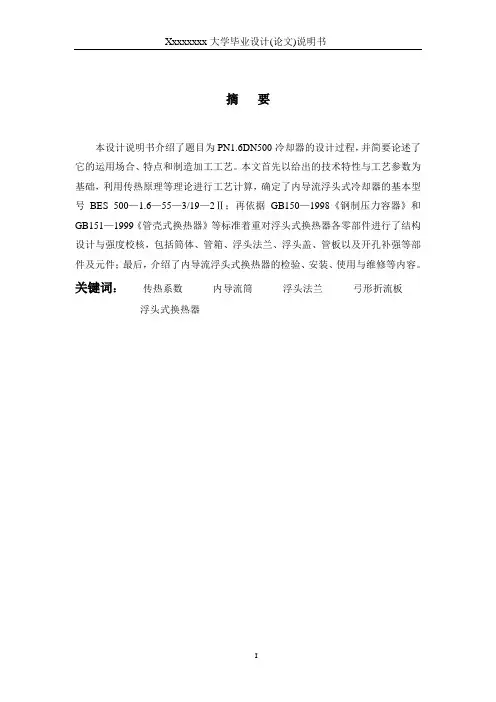
摘要本设计说明书介绍了题目为PN1.6DN500冷却器的设计过程,并简要论述了它的运用场合、特点和制造加工工艺。
本文首先以给出的技术特性与工艺参数为基础,利用传热原理等理论进行工艺计算,确定了内导流浮头式冷却器的基本型号BES 500—1.6—55—3/19—2Ⅱ;再依据GB150—1998《钢制压力容器》和GB151—1999《管壳式换热器》等标准着重对浮头式换热器各零部件进行了结构设计与强度校核,包括筒体、管箱、浮头法兰、浮头盖、管板以及开孔补强等部件及元件;最后,介绍了内导流浮头式换热器的检验、安装、使用与维修等内容。
关键词:传热系数内导流筒浮头法兰弓形折流板浮头式换热器AbstractThis design specifications introduces the design process of PN1.6 DN500 cooler, and expounds briefly the utilization situation、characteristic and manufacture process. Firstly, It is based on physical technical characteristic and technology parameter given in the production that the technology calculation is done by making use of fundamentals about heat transfer process in order to define the model of floating-head type cooler with inner diversion tube,which is BES 500—1.6—44.9—3/25—2Ⅱ. Then, the structural design and intensity examination about most of components in heat exchanger are carried out by means of standards, such as GB150—1998<Steel pressure vessels> and GB151—1999<shell and tube heat exchanger>,including tube body、tube box、floating head flange、floating head cover、the tube plate as well as reinforcement for opening and so on. Finally, it is also related to inspection、installation、operation and maintenance about floating-head type heat exchanger with inner diversion tube.Key word: heat transfer coefficient ;inner diversion tube ; floating head flange;flow resistance;segmental baffle;floating-head type heat exchanger ;目录摘要 (I)Abstract....................................................... I I 绪论. (1)第一章方案论证 (5)1.2 经济合理性 (7)1.3 结构可操作性 (7)第二章结构及强度设计 (9)2.1 筒体结构设计及计算[1] (9)2.1.1. 筒体厚度计算 (9)2.1.2 筒体的强度校核和水压试验 (10)2.2 管箱结构设计 (11)2.2.1封头的材料及形式选择[14] (11)2.2.2标准封头壁厚计算 (11)2.2.3管箱应力校核 (12)2.2.4 管箱的结构设计 (12)2.3 管箱法兰设计 (13)2.3.1 法兰选用[5] (13)2.3.2垫片选用[8] (13)2.3.3螺柱与螺母选用[5] (14)2.3.4管箱法兰计算及校核[2] (14)2.4 钩圈式浮头的设计 (19)2.4.1 钩圈式浮头的结构尺寸计算 (19)2.4.2 浮头盖的设计计算 (20)2.4.3浮头钩圈的设计计算 (28)2.5 换热管及管板的设计 (28)2.5.1、换热管的设计 (28)2.5.2 换热器管板设计 (30)2.6 外头盖设计 (35)2.6.1 外头盖侧法兰选用[10] (35)2.6.2.外头盖法兰选用[5] (36)2.6.3.外头盖垫片及其它[9] (36)2.6.4 外头盖封头的设计[14] (36)2.7 开孔补强设计[1] (37)3.7.1 补强判别 (37)2.7.3.封头开孔补强计算 (39)2.8 其他零部件设计[2] (40)2.8.1拉杆设计 (40)2.8.2 分程隔板设计 (41)2.8.3 定距管设计 (41)2.8.4滑道设计 (41)2.8.5 折流板的设计计算 (41)P) (43)2.8.6. 防冲板设计(GB151- 1999,762.8.7. 内导流筒的选用 (43)2.8.8. 防短路结构设计 (43)2.8.9. 鞍式支座的选用[11] (44)2.8.10. 预防管束发生振动破坏的措施 (45)第三章浮头式换热器的制造、检验与验收 (46)3.1浮头式换热器制造、检验与验收要求 (46)3.2浮头式换热器的制造工艺[4] (46)3.2.1主要零部件的加工工艺 (46)3.2.3 浮头式换热器的焊接工艺 (49)3.2.4 浮头式换热器的涂漆工艺 (51)3.3浮头式换热器的检验与验收 (51)3.3.1 换热器常见的试验工艺及要求 (52)3.3.2 浮头式换热器的检验工艺 (52)第四章浮头式换热器的安装、使用与维修 (54)4.1浮头式换热器的安装要求 (54)4.2浮头式换热器的使用与维修[4] (54)4.2.1浮头式换热器使用时常见的几种破坏形式 (54)4.2.2浮头式换热器的维修 (55)第五章分析与总结 (56)设计小结 (57)参考文献 (58)致谢 (59)绪论过程设备在生产技术领域中应用非常广泛,是化工、炼油、轻工、交通、食品、制药、冶金、能源、纺织、宇航、城建、国防、海洋工程等传统部门所必需的关键设备。
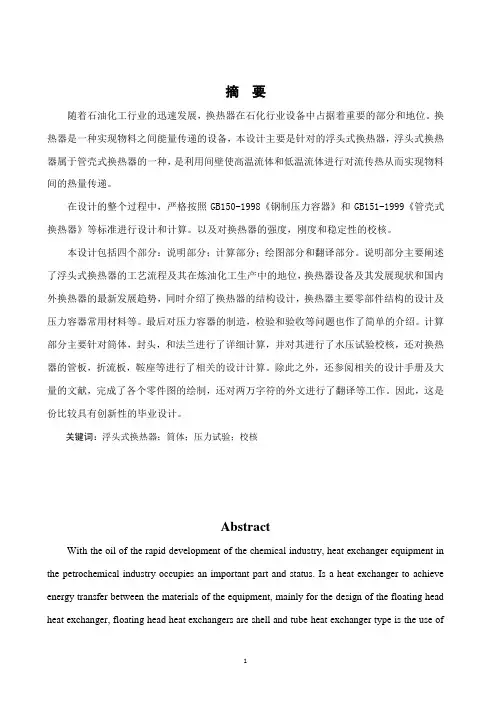
摘要随着石油化工行业的迅速发展,换热器在石化行业设备中占据着重要的部分和地位。
换热器是一种实现物料之间能量传递的设备,本设计主要是针对的浮头式换热器,浮头式换热器属于管壳式换热器的一种,是利用间壁使高温流体和低温流体进行对流传热从而实现物料间的热量传递。
在设计的整个过程中,严格按照GB150-1998《钢制压力容器》和GB151-1999《管壳式换热器》等标准进行设计和计算。
以及对换热器的强度,刚度和稳定性的校核。
本设计包括四个部分:说明部分;计算部分;绘图部分和翻译部分。
说明部分主要阐述了浮头式换热器的工艺流程及其在炼油化工生产中的地位,换热器设备及其发展现状和国内外换热器的最新发展趋势,同时介绍了换热器的结构设计,换热器主要零部件结构的设计及压力容器常用材料等。
最后对压力容器的制造,检验和验收等问题也作了简单的介绍。
计算部分主要针对筒体,封头,和法兰进行了详细计算,并对其进行了水压试验校核,还对换热器的管板,折流板,鞍座等进行了相关的设计计算。
除此之外,还参阅相关的设计手册及大量的文献,完成了各个零件图的绘制,还对两万字符的外文进行了翻译等工作。
因此,这是份比较具有创新性的毕业设计。
关键词:浮头式换热器;筒体;压力试验;校核AbstractWith the oil of the rapid development of the chemical industry, heat exchanger equipment in the petrochemical industry occupies an important part and status. Is a heat exchanger to achieve energy transfer between the materials of the equipment, mainly for the design of the floating head heat exchanger, floating head heat exchangers are shell and tube heat exchanger type is the use ofpartitions so that high-temperature fluid and low-temperature fluid for convective heat transfer in order to achieve the heat transfer between materials.In the design of the whole process, in strict accordance with GB150-1998 "Steel Pressure Vessels" and GB151-1999 "shell and tube heat exchanger" and other standards for the design and calculation. As well as the heat exchanger strength, stiffness and stability of the check.The design includes four parts: that part of it; calculation part; mapping and translation of some parts. Note on some of the main floating head heat exchanger and its application in the process of refining the position of chemical production, heat exchanger and the development of equipment and heat exchangers at home and abroad the latest development trends, at the same time introduced the structure of heat exchanger design, heat exchanger design of the structure of the main components and pressure vessels commonly used materials. Finally, pressure vessel manufacturing, testing and acceptance of other issues also made a brief introduction. Calculated for some of the main cylinder, head, and carried out a detailed calculation of the flange, and its hydraulic test checking, but also on the heat exchanger tube sheet, baffle, such as a saddle-related design calculation. In addition, see the related design manuals and a lot of literature, completed the mapping of various parts, but also on the20,000 foreign-language characters for the translation work. Therefore, it is a comparison of graduates with innovative design.Key words:Floating head heat exchanger; cylinder; pressure test; check目录1前言 (1)1.1管壳式换热器的分类 (1)1.2管壳式换热器的结构 (2)1.2.1管束 (2)1.2.2壳程 (3)1.2.3管子的排列方式 (3)1.2.4管板 (3)1.2.5折流板与折流杆 (3)1.3管壳式换热器相关分析 (4)1.3.1传热系数 (4)1.3.2平均温差 (4)1.3.3流体流速 (4)1.3.4流体压降 (4)1.3.5振动 (4)1.3.6其他 (4)1.4提高管壳式换热器传热能力的措施 (5)1.5管壳式换热器工作原理 (6)1.6管壳式换热器的发展 (7)1.6.1板式支承结构的发展 (7)1.6.2杆式支承结构的发展 (7)1.6.3空心环支承结构 (8)1.6.4管式自支承 (9)1.7管壳式换热器特点 (10)1.8管壳式与其他换热器的比较 (11)1.9腐蚀与防护 (14)1.9.1换热器腐蚀的原因 (14)1.9.2管壳式换热器的防腐蚀措施 (16)1.10换热器设计软件简介 (19)1.10.1HTFS (20)1.10.2 HTRI (21)1.10.3 ASPEN PLUS B—JAC (22)1.11结语 (23)2设计部分 (24)2.1浮头式换热器筒体的计算: (24)2.1.1计算条件 (24)2.1.2厚度的计算 (24)2.2前后端管箱封头的计算 (25)2.2.1设计条件 (25)2.2.2厚度计算 (25)2.2.3压力试验应力校核 (26)2.2.4压力试验应力校核 (27)2.3带法兰无折边球形封头及法兰计算 (27)2.3.1设计条件 (27)2.3.2厚度计算 (28)2.4管子排列方式的设计 (31)2.5开孔补强的计算 (31)2.5.1筒体开孔所需的补强面积要求 (32)2.5.2在有效补强范围内作为补强的截面积 (32)2.5.3选择补强圈补强 (33)2.6外头盖法兰厚度计算 (33)2.6.1设计条件 (33)2.6.2厚度计算 (34)2.7管板的厚度计算 (38)2.7.1设计条件 (38)2.7.2计算各参数 (39)2.7.3厚度计算 (41)2.7.4校核换热管轴向力 (42)3 致谢 (45)4 参考文献 (46)1 前言换热器是一种实现物料之间热量传递的节能设备,在石油、化工、冶金、电力、轻工、食品等行业应用普遍。

浮头式换热器毕业设计浮头式换热器毕业设计近年来,随着工业的快速发展和能源的日益紧缺,节能减排成为了各行各业的共同追求。
在众多的节能技术中,换热器作为一种重要的设备,扮演着至关重要的角色。
而浮头式换热器作为一种常用的换热设备,其设计和优化也成为了研究的热点之一。
浮头式换热器是一种常用于化工、石油、制药等领域的换热设备。
它由固定在壳体内的管束和可以上下浮动的浮头组成。
在换热过程中,热媒在管束内流动,而被换热介质则在壳体内流动,通过管壳两侧的传热界面进行热量的传递。
浮头式换热器的设计和优化旨在提高换热效率、降低能耗和减少设备的占地面积。
在浮头式换热器的设计中,流体力学和传热学是两个重要的研究方向。
流体力学研究主要关注流体在管束和壳体内的流动规律,以及流体的压降和速度分布等参数。
传热学研究则关注热媒和被换热介质之间的热量传递过程,包括传热系数、传热面积和传热效率等指标。
通过对流体力学和传热学的研究,可以优化换热器的结构和参数,提高其性能和效率。
在浮头式换热器的设计过程中,需要考虑多个因素。
首先是换热器的尺寸和形状。
尺寸和形状的选择直接影响到换热器的传热和流体力学性能。
一般来说,较大的尺寸和复杂的形状可以增加传热面积,提高传热效率,但也会增加设备的成本和能耗。
因此,在设计过程中需要综合考虑各种因素,找到最佳的尺寸和形状。
其次是换热器的材料选择。
换热器的材料需要具有良好的传热性能和耐腐蚀性能。
常用的材料包括不锈钢、铜、铝等。
不同的材料有不同的特点和适用范围,需要根据具体的工艺要求和工作环境选择合适的材料。
此外,还需要考虑材料的成本和可持续性,以及对环境的影响。
最后是换热器的操作和维护。
换热器的操作和维护对于其性能和寿命都有重要影响。
在操作过程中,需要合理控制流体的流量和温度,以及维持换热器的清洁和正常运行。
在维护过程中,需要定期清洗和检查换热器的管束和壳体,以防止堵塞和腐蚀等问题。
总之,浮头式换热器作为一种重要的换热设备,在工业生产中发挥着重要作用。
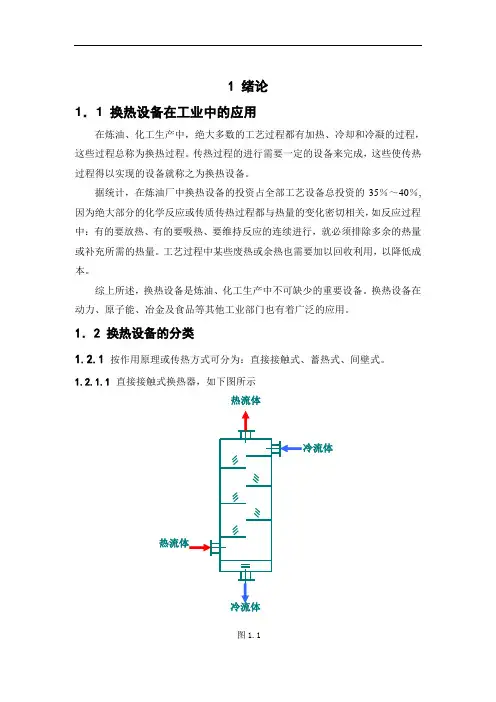
1 绪论1.1 换热设备在工业中的应用在炼油、化工生产中,绝大多数的工艺过程都有加热、冷却和冷凝的过程,这些过程总称为换热过程。
传热过程的进行需要一定的设备来完成,这些使传热过程得以实现的设备就称之为换热设备。
据统计,在炼油厂中换热设备的投资占全部工艺设备总投资的35%~40%,因为绝大部分的化学反应或传质传热过程都与热量的变化密切相关,如反应过程中:有的要放热、有的要吸热、要维持反应的连续进行,就必须排除多余的热量或补充所需的热量。
工艺过程中某些废热或余热也需要加以回收利用,以降低成本。
综上所述,换热设备是炼油、化工生产中不可缺少的重要设备。
换热设备在动力、原子能、冶金及食品等其他工业部门也有着广泛的应用。
1.2 换热设备的分类1.2.1按作用原理或传热方式可分为:直接接触式、蓄热式、间壁式。
1.2.1.1直接接触式换热器,如下图所示热流体图1.1其传热的效果好,但不能用于发生反应或有影响的流体之间。
蓄热式换热器,如下图所示图1.2其适用于温度较高的场合,但有交叉污染,温度被动大。
1.2.1.3 间壁式换热器,又称表面式换热器利用间壁进行热交换。
冷热两种流体隔开,互不接触,热量由热流体通过间壁传递给冷流体。
1.2.2 按其工艺用途可分为:冷却器(cooler)、冷凝器(condenser)、加热器(一般不发生相变)(heater)、蒸发器(发生相变)(evaporator)、再沸器(reboiler)、废热锅炉(waste heat boiler)。
1.2.3 按材料分类:分为金属材料和非金属材料换热器。
1.3 国内外的研究现状上个世纪70年代初发生世界性能源危机,有力地促进了传热强化技术的发展。
为了节能降耗,提高工业生产的经济效益,要求开发适用不同工业过程要求的高效能换热设备。
因此,几十年来,高效换热器的开发与研究始终是人们关注的课题,国内外先后推出了一系列新型高效换热器。
近年来,国内已经进行了大量的强化传热技术的研究,但在新型高效换热器的开发方面与国外差距仍然较大,并且新型高效换热器的实际推广和应用仍非常有限。
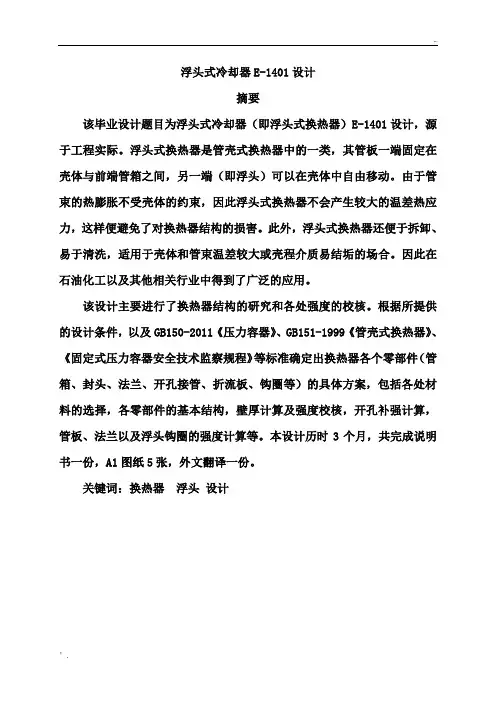
浮头式冷却器E-1401设计摘要该毕业设计题目为浮头式冷却器(即浮头式换热器)E-1401设计,源于工程实际。
浮头式换热器是管壳式换热器中的一类,其管板一端固定在壳体与前端管箱之间,另一端(即浮头)可以在壳体中自由移动。
由于管束的热膨胀不受壳体的约束,因此浮头式换热器不会产生较大的温差热应力,这样便避免了对换热器结构的损害。
此外,浮头式换热器还便于拆卸、易于清洗,适用于壳体和管束温差较大或壳程介质易结垢的场合。
因此在石油化工以及其他相关行业中得到了广泛的应用。
该设计主要进行了换热器结构的研究和各处强度的校核。
根据所提供的设计条件,以及GB150-2011《压力容器》、GB151-1999《管壳式换热器》、《固定式压力容器安全技术监察规程》等标准确定出换热器各个零部件(管箱、封头、法兰、开孔接管、折流板、钩圈等)的具体方案,包括各处材料的选择,各零部件的基本结构,壁厚计算及强度校核,开孔补强计算,管板、法兰以及浮头钩圈的强度计算等。
本设计历时3个月,共完成说明书一份,A1图纸5张,外文翻译一份。
关键词:换热器浮头设计Floating cooler E-1401 designSummaryThe graduation project titled Floating cooler ( ie, floating head heat exchanger ) E-1401 design , from engineering practice . Floating head heat exchanger shell and tube heat exchanger is in a class of its tube plate fixed at one end between the housing and the front tube box , the other end ( ie, floating head ) can move freely in the housing. Due to thermal expansion of the bundle is not bound by the housing , the floating head heat exchanger and therefore no large temperature difference between the thermal stress , thus avoiding damage to the structure of the heat exchanger . In addition, floating head heat exchanger is also easy to disassemble , easy to clean , suitable for large temperature difference between the shell and tube bundle or medium shell easy to scale the occasion. So it has been widely used in the petrochemical and other related industries.The design is mainly studied the intensity of the heat exchanger and around the structure checked. Determine the various components of the heat exchanger according to the design conditions provided and GB150-2011 " pressure vessel ", GB151-1999 " shell and tube heat exchangers ", " Safety Technology Supervision Stationary Pressure Vessels " and other standards ( tube box , head, flange , opening over, baffles, circle hooks , etc. ) of the specific program , including the selection of materials throughout , the basic structure of the various parts , wall thickness calculation and strength check , opening reinforcement calculations, tube sheets , flanges and strength calculation Floating circle hook .Keywords : Heat exchanger floating head design1.前言随着时代的发展、科技的进步,石油化工及相关产业在人类的生活中扮演的角色越来越不可替代。

1 绪论1.1 换热设备在工业中的应用在炼油、化工生产中,绝大多数的工艺过程都有加热、冷却和冷凝的过程,这些过程总称为换热过程。
传热过程的进行需要一定的设备来完成,这些使传热过程得以实现的设备就称之为换热设备。
据统计,在炼油厂中换热设备的投资占全部工艺设备总投资的35%~40%,因为绝大部分的化学反应或传质传热过程都与热量的变化密切相关,如反应过程中:有的要放热、有的要吸热、要维持反应的连续进行,就必须排除多余的热量或补充所需的热量。
工艺过程中某些废热或余热也需要加以回收利用,以降低成本。
综上所述,换热设备是炼油、化工生产中不可缺少的重要设备。
换热设备在动力、原子能、冶金及食品等其他工业部门也有着广泛的应用。
1.2 换热设备的分类1.2.1按作用原理或传热方式可分为:直接接触式、蓄热式、间壁式。
1.2.1.1直接接触式换热器,如下图所示热流体图1.1其传热的效果好,但不能用于发生反应或有影响的流体之间。
蓄热式换热器,如下图所示图1.2其适用于温度较高的场合,但有交叉污染,温度被动大。
1.2.1.3 间壁式换热器,又称表面式换热器利用间壁进行热交换。
冷热两种流体隔开,互不接触,热量由热流体通过间壁传递给冷流体。
1.2.2 按其工艺用途可分为:冷却器(cooler)、冷凝器(condenser)、加热器(一般不发生相变)(heater)、蒸发器(发生相变)(evaporator)、再沸器(reboiler)、废热锅炉(waste heat boiler)。
1.2.3 按材料分类:分为金属材料和非金属材料换热器。
1.3 国内外的研究现状上个世纪70年代初发生世界性能源危机,有力地促进了传热强化技术的发展。
为了节能降耗,提高工业生产的经济效益,要求开发适用不同工业过程要求的高效能换热设备。
因此,几十年来,高效换热器的开发与研究始终是人们关注的课题,国内外先后推出了一系列新型高效换热器。
近年来,国内已经进行了大量的强化传热技术的研究,但在新型高效换热器的开发方面与国外差距仍然较大,并且新型高效换热器的实际推广和应用仍非常有限。
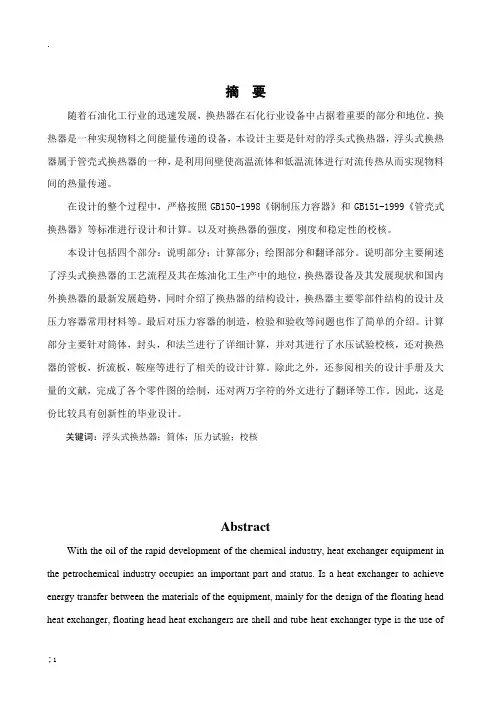
摘要随着石油化工行业的迅速发展,换热器在石化行业设备中占据着重要的部分和地位。
换热器是一种实现物料之间能量传递的设备,本设计主要是针对的浮头式换热器,浮头式换热器属于管壳式换热器的一种,是利用间壁使高温流体和低温流体进行对流传热从而实现物料间的热量传递。
在设计的整个过程中,严格按照GB150-1998《钢制压力容器》和GB151-1999《管壳式换热器》等标准进行设计和计算。
以及对换热器的强度,刚度和稳定性的校核。
本设计包括四个部分:说明部分;计算部分;绘图部分和翻译部分。
说明部分主要阐述了浮头式换热器的工艺流程及其在炼油化工生产中的地位,换热器设备及其发展现状和国内外换热器的最新发展趋势,同时介绍了换热器的结构设计,换热器主要零部件结构的设计及压力容器常用材料等。
最后对压力容器的制造,检验和验收等问题也作了简单的介绍。
计算部分主要针对筒体,封头,和法兰进行了详细计算,并对其进行了水压试验校核,还对换热器的管板,折流板,鞍座等进行了相关的设计计算。
除此之外,还参阅相关的设计手册及大量的文献,完成了各个零件图的绘制,还对两万字符的外文进行了翻译等工作。
因此,这是份比较具有创新性的毕业设计。
关键词:浮头式换热器;筒体;压力试验;校核AbstractWith the oil of the rapid development of the chemical industry, heat exchanger equipment in the petrochemical industry occupies an important part and status. Is a heat exchanger to achieve energy transfer between the materials of the equipment, mainly for the design of the floating head heat exchanger, floating head heat exchangers are shell and tube heat exchanger type is the use ofpartitions so that high-temperature fluid and low-temperature fluid for convective heat transfer in order to achieve the heat transfer between materials.In the design of the whole process, in strict accordance with GB150-1998 "Steel Pressure Vessels" and GB151-1999 "shell and tube heat exchanger" and other standards for the design and calculation. As well as the heat exchanger strength, stiffness and stability of the check.The design includes four parts: that part of it; calculation part; mapping and translation of some parts. Note on some of the main floating head heat exchanger and its application in the process of refining the position of chemical production, heat exchanger and the development of equipment and heat exchangers at home and abroad the latest development trends, at the same time introduced the structure of heat exchanger design, heat exchanger design of the structure of the main components and pressure vessels commonly used materials. Finally, pressure vessel manufacturing, testing and acceptance of other issues also made a brief introduction. Calculated for some of the main cylinder, head, and carried out a detailed calculation of the flange, and its hydraulic test checking, but also on the heat exchanger tube sheet, baffle, such as a saddle-related design calculation. In addition, see the related design manuals and a lot of literature, completed the mapping of various parts, but also on the20,000 foreign-language characters for the translation work. Therefore, it is a comparison of graduates with innovative design.Key words:Floating head heat exchanger; cylinder; pressure test; check目录1前言 (1)1.1管壳式换热器的分类 (1)1.2管壳式换热器的结构 (2)1.2.1管束 (2)1.2.2壳程 (3)1.2.3管子的排列方式 (3)1.2.4管板 (3)1.2.5折流板与折流杆 (3)1.3管壳式换热器相关分析 (4)1.3.1传热系数 (4)1.3.2平均温差 (4)1.3.3流体流速 (4)1.3.4流体压降 (4)1.3.5振动 (4)1.3.6其他 (4)1.4提高管壳式换热器传热能力的措施 (5)1.5管壳式换热器工作原理 (6)1.6管壳式换热器的发展 (7)1.6.1板式支承结构的发展 (7)1.6.2杆式支承结构的发展 (7)1.6.3空心环支承结构 (8)1.6.4管式自支承 (9)1.7管壳式换热器特点 (10)1.8管壳式与其他换热器的比较 (11)1.9腐蚀与防护 (14)1.9.1换热器腐蚀的原因 (14)1.9.2管壳式换热器的防腐蚀措施 (16)1.10换热器设计软件简介 (19)1.10.1HTFS (20)1.10.2 HTRI (21)1.10.3 ASPEN PLUS B—JAC (22)1.11结语 (23)2设计部分 (24)2.1浮头式换热器筒体的计算: (24)2.1.1计算条件 (24)2.1.2厚度的计算 (24)2.2前后端管箱封头的计算 (25)2.2.1设计条件 (25)2.2.2厚度计算 (25)2.2.3压力试验应力校核 (26)2.2.4压力试验应力校核 (27)2.3带法兰无折边球形封头及法兰计算 (27)2.3.1设计条件 (27)2.3.2厚度计算 (28)2.4管子排列方式的设计 (31)2.5开孔补强的计算 (31)2.5.1筒体开孔所需的补强面积要求 (32)2.5.2在有效补强范围内作为补强的截面积 (32)2.5.3选择补强圈补强 (33)2.6外头盖法兰厚度计算 (33)2.6.1设计条件 (33)2.6.2厚度计算 (34)2.7管板的厚度计算 (38)2.7.1设计条件 (38)2.7.2计算各参数 (39)2.7.3厚度计算 (41)2.7.4校核换热管轴向力 (42)3 致谢 (45)4 参考文献 (46)1 前言换热器是一种实现物料之间热量传递的节能设备,在石油、化工、冶金、电力、轻工、食品等行业应用普遍。



浮头式换热器设计说明书————————————————————————————————作者:————————————————————————————————日期:武汉工程大学邮电与信息工程学院毕业设计(论文)说明书论文题目 BES-900-1.0-165-4.5/25-2Ⅱ浮头式换热器设计学号 1002050314 学生姓名刘成专业班级 10过程装备与控制工程03班指导教师刘丽芳总评成绩2014年 6 月 1 日摘要 (2)Abstract (3)绪论 (4)一换热器的简单介绍 (4)二换热器的应用 (4)三管壳式换热器的分类及其特点 (4)四换热器在化学工业中的应用 (5)五换热器的选型 (7)第一章结构及强度计算 (8)1.1筒体的计算 (8)1.2管箱的结构设计 (9)1.3 浮头盖的设计 (14)1.4管板的计算 (27)1.5外头盖的计算 (32)1.6开孔补强计算 (33)1.7其他零部件设计 (36)第二章浮头式换热器的制造工艺 (41)2.1 总体制造工艺 (41)2.2 管箱、壳体、头盖的制造工艺 (41)2.3 换热管的制造工艺 (41)2.4 管板与折流板的制造工艺 (41)第三章浮头式换热器的检验、安装、使用和维修 (43)3.1换热管的水压试验 (43)3.2安装 (43)3.3使用 (44)3.4维护 (44)设计总结 (45)致谢 (46)参考文献 (47)附录 (48)换热器是将热流体的部分热量传递给冷流体的设备,又称热交换器。
换热器的应用广泛,它的主要功能是保证工艺过程对介质所要求的特定温度,同时也是提高能源利用率的主要设备之一。
换热器既可是一种单独的设备,如加热器、冷却器和凝汽器等;也可是某一工艺设备的组成部分,如氨合成塔内的热交换器。
本设计说明书是关于浮头式换热器的设计,主要是进行了换热器的结构和强度设计。
这部分主要是根据设计课题和课题给定条件进行设备内各零部件(如管箱、浮头钩圈、管板、接管、折流板、隔板、定距管等)的设计,包括:材料的选择、具体尺寸确定、确定具体位置、管板厚度的计算、浮头盖和浮头法兰厚度的计算、开孔补强计算等。